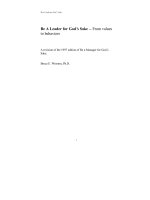ELECTROPHYSIOLOGY – FROM PLANTS TO HEART doc
Bạn đang xem bản rút gọn của tài liệu. Xem và tải ngay bản đầy đủ của tài liệu tại đây (16.27 MB, 212 trang )
ELECTROPHYSIOLOGY –
FROM PLANTS TO HEART
Edited by Saeed Oraii
Electrophysiology – From Plants to Heart
Edited by Saeed Oraii
Published by InTech
Janeza Trdine 9, 51000 Rijeka, Croatia
Copyright © 2012 InTech
All chapters are Open Access distributed under the Creative Commons Attribution 3.0
license, which allows users to download, copy and build upon published articles even for
commercial purposes, as long as the author and publisher are properly credited, which
ensures maximum dissemination and a wider impact of our publications. After this work
has been published by InTech, authors have the right to republish it, in whole or part, in
any publication of which they are the author, and to make other personal use of the
work. Any republication, referencing or personal use of the work must explicitly identify
the original source.
As for readers, this license allows users to download, copy and build upon published
chapters even for commercial purposes, as long as the author and publisher are properly
credited, which ensures maximum dissemination and a wider impact of our publications.
Notice
Statements and opinions expressed in the chapters are these of the individual contributors
and not necessarily those of the editors or publisher. No responsibility is accepted for the
accuracy of information contained in the published chapters. The publisher assumes no
responsibility for any damage or injury to persons or property arising out of the use of any
materials, instructions, methods or ideas contained in the book.
Publishing Process Manager Dejan Grgur
Technical Editor Teodora Smiljanic
Cover Designer InTech Design Team
First published February, 2012
Printed in Croatia
A free online edition of this book is available at www.intechopen.com
Additional hard copies can be obtained from
Electrophysiology – From Plants to Heart, Edited by Saeed Oraii
p. cm.
ISBN 978-953-51-0006-5
Contents
Preface IX
Chapter 1 Electrophysiology of Woody Plants 1
Luis A. Gurovich
Chapter 2 Pacemaker Currents
in Dopaminergic Neurones of the Mice Olfactory Bulb 25
Angela Pignatelli, Cristina Gambardella, Mirta Borin,
Alex Fogli Iseppe and Ottorino Belluzzi
Chapter 3 Hippocampal Slices and Their Electrophysiogy
in the Study of Brain Energy Metabolism 51
Avital Schurr
Chapter 4 Evoked Potentials 83
Ahmet Akay
Chapter 5 Diagnostic Values
of Electrophysiology in Ophthalmology 109
Morteza Movassat
Chapter 6 Right Ventricular Pacing
and Mechanical Dyssynchrony 135
Kevin V. Burns, Ryan M. Gage and Alan J. Bank
Chapter 7 Noninvasive Imaging
of Cardiac Electrophysiology (NICE) 157
Michael Seger, Bernhard Pfeifer and Thomas Berger
Chapter 8 Past, Present and Future Catheter Technologies
and Energy Sources for Atrial Fibrillation Ablation 187
Inderpal Singh, Adam Price, Zachary Leshen and Boaz Avitall
Preface
Enormous progress has been made in the science of Electrophysiology over the last
two centuries or more. William Gilbert, the physician of Queen Elizabeth I, first
introduced the term “electrica” in the year 1600, for objects that hold static electricity.
He derived it from the Greek word for amber (electra). The introduction of
“bioelectricity” however, dates back to the works of Luigi Galvani in 1787, and his
observations that a frog nerve-muscle preparation could be contracted by delivering
electrical impulses.
From 1825, the development of sensitive galvanometers by Leopoldo Nobili made it
possible to record charges and currents within the animal cells. Further investigations
into the nature of “animal electricity” led to the demonstration of the resting heart
muscle electrical currents by Carlo Matteucci in 1838, and this can truly be considered
as the birth of cardiac electrophysiology.
In 1877, Augustus Desiree Waller was the first to record electric potentials associated
with the beating heart from the body surface: the first human electrocardiogram. This
was made possible by the invention of a capillary electrometer by Thomas Goswell, a
technician in his laboratory.
During subsequent years, the outstanding evolution of recording techniques paved the
way for better understanding of electrophysiological phenomena within the human
organs, including the cardiovascular, ophthalmologic and neural systems. In the field
of cardiac electrophysiology, the development of more and more sophisticated
recording and mapping techniques made it possible to elucidate the mechanism of
various cardiac arrhythmias. This has even led to the evolution of techniques to ablate
and cure most complex cardiac arrhythmias. Nevertheless, there is still a long way
ahead and this book can be considered a valuable addition to the current knowledge
in subjects related to bioelectricity from plants to the human heart.
Saeed Oraii MD,
Cardiologist, Interventional Electrophysiologist
Tehran Arrhythmia Clinic, Teheran
Iran
1
Electrophysiology of Woody Plants
Luis A. Gurovich
Universidad Católica de Chile
Chile
1. Introduction
A fundamental property of all living organisms is related to the continuous gathering of
environmental information and the expression of physiological responses aimed to optimize
its performance under new environmental conditions. In order to keep homeostasis, plants
need to continuously gather information about its environment and to react physiologically,
in order to synchronize its normal biological functions. Plant cells become bio -
electrochemically excited under the influence of environmental changes and the conduction
of these electric potential modifications to distant plant organs have been widely reported.
Electrochemical phenomena in plants have attracted researchers since the eighteenth
century (Bertholon, 1783; Burdon-Sanderson, 1873; Darwin, 1875; Lemström, 1904; Bose,
1926); however, only in the last decade numerous papers related to plant electrophysiology
have been published (for a comprehensive review on the subject see Volkov´s book “Plant
Electrophysiology, Theory and Methods”, 2006). Detection of electrical potentials in plants
indicates that electrical signaling is a major system to transmit information over long
distances throughout its organs. The reason why plants have developed pathways for
electrical signal transmission is probably related to its need to respond rapidly to
environmental stress factors (Fromm & Lautner, 2007). Electrophysiological studies of long-
distance signals in plants and animals contribute to our knowledge of the living world by
revealing important similarities and crucial differences between plants and animals, in an
area that might be directly related to their different capacities to respond to environmental
change.
The existence of electrophysiological mechanisms for information perception, transmission
and processing between different plant organs and tissues, allowing the expression of fast
and accurate physiological reactions to specific biotic or abiotic stimuli, is expressed by
means of real-time detectable action (APs) and variation (VPs) potentials (Datta & Palit, 2004;
Gil et al., 2008; Lautner et al., 2005; Oyarce & Gurovich, 2010; Volkov et al., 2009; Wang et
al., 2009). An additional type of electric potential in plants has been proposed by
Zimmermann et al. (2009), to be called system potential. In addition to APs that occur also in
animals and lower plants (Trebacz et al., 2005) higher plants feature an additional, unique,
hydraulically propagated type of electric signals VPs, called also slow wave potentials
(Stahlberg et al., 2005).
Several models have been proposed to explain the onset of plant cell electric excitation,
resulting from external stimuli (Wayne, 1993; Fromm & Lautner, 2007). All plant cells are
Electrophysiology – From Plants to Heart
2
surrounded by a plasma membrane (Murphy et al., 2010), composed of a lipid bilayer, with
a variety of molecular structures embedded in it, known generically as ion channels and
electrogenic pumps (Hedrich & Schroeder, 1989). Electrochemical excitation is caused by ionic
fluxes through the cell plasma membrane (Knudsen, 2002; Blatt, 2008), creating an electric
charge modification in the membrane itself, as well as a differential charge on either side.
This trans - membrane potential is the difference in voltage (or electrical potential
difference) between the interior and exterior of a cell (V
interior
− V
exterior
). Plant plasma
membranes always maintain a potential, the cell interior being more negative than the
exterior, arising mainly from the activity of electrogenic pumps. As an example, H
+
-
transporting ATPases (Sze et al., 1999) pump protons out of the cell, thus maintaining a pH
gradient across the plasma membrane. This process is involved in the simultaneous symport
of carbohydrates and amino acids into the cell, which are produced at different plant tissues
as photosynthetic derivatives. Other electrogenic ion pumps described for plant cell plasma
membranes are related to ion and solute fluxes, underpinning inorganic mineral nutrient
uptake; they trigger rapid changes in secondary messengers such as cytosolic-free
Ca
+2
concentrations, and also power the osmotic gradients that drive cell expansion
(Schroeder & Thuleau 1991; Gelli & Blumwald, 1997; Zimmermann et al., 1997; Bonza et al.,
2001; Sanders, 2002; Blatt, 2008; Lautner & Fromm, 2010). The K
+1
-transporting ATPase, also
embedded in the cell plasma membrane, enables the onset of different ion concentrations
(and therefore electrical charge) on the intracellular and extracellular sides of the membrane
(Maathuis & Sanders, 1997).
Ion channels, when active, partially discharge the plasma membrane potential, while the
electrogenic pumps restore and maintain it (Fromm & Spanswick, 1993; Neuhaus & Wagner,
2000). The plasma membrane potential has two basic functions. First, it allows a cell to
function as a battery, providing power to operate the variety of electrogenic pumps
embedded in its lipid bilayer. Second, in electrically excitable cells, it is used for transmitting
signals between different parts of a cell or to other plant cells, tissues or organs. Opening or
closing of ion channels at one point in the membrane produces a local and transient change
in the membrane potential, which causes an electric current to flow rapidly to other points
in the membrane and eventually, to the plasma membrane of surrounding cells. In non-
excitable cells, and in excitable cells in their baseline state, the membrane potential is held at
a relatively stable value, called the resting potential, characterized by its absence of
fluctuations; the resting potential varies from −20 mV to −200 mV according to cell type.
Opening and closing of ion channels can induce a departure from the resting potential,
called a depolarization if the interior voltage rises, or a hyperpolarization if the interior voltage
becomes more negative. In excitable cells, a sufficiently large depolarization can evoke an
action potential (AP), in which the membrane potential very rapidly undergoes a significant,
measurable change, often briefly reversing its sign; AP are short-lasting, all-or-nothing
events.
Change in trans – plasma membrane potential creates a wave of depolarization, which affects
the adjoining resting plasma membranes, thus generating an impulse. Once initiated, these
impulses can propagate to adjacent excitable cells. Electrical signals can propagate along the
plasma membrane (Van Bel & Ehlers, 2005; Volkov et al., 2011) on short distances through
plasmodesmata and on long distances in plant phloematic tissue (Ksenzhek & Volkov, 1998;
Volkov, 2000; Volkov, 2006; Volkov et al., 2011).
Electrophysiology of Woody Plants
3
Research on the subject of electrochemical phenomena in plants is generically known as
plant electrophysiology (Volkov, 2006); this knowledge is the basis of a newly developed
discipline in the field of plant physiology: plant neurobiology (Brenner et al, 2006; Stahlberg,
2006; Baluška & Mancuso, 2008; Barlow, 2008). Plant neurobiology is aimed at establishing
the structure of information networks that exist within the plant, which is expressed as
responses to environmental stimuli by means of electrochemical signals (Baluška et al., 2004;
Trewavas, 2005). These signals seem to complement other plant signals: hydraulic,
mechanical, volatile and hormonal, already well documented in plant science (Fromm &
Lautner, 2007; Gil et al., 2009; Dziubinska et al., 2003).
Research on plant electrophysiology specifically focused on woody plants like poplar and
willow trees, have been seldom reported (Fromm & Spanswick, 1993; Lautner et al, 2005;
Gibert et al., 2006). In fruit bearing deciduous and perennial plant species, electrophysiology
studies are very limited as well, although it is in such plants that the need for rapid and
efficient signals other than chemical and hydraulic signaling becomes more obvious (Gil et
al., 2008; Nadler et al. 2008; Gurovich & Hermosilla, 2009; Oyarce & Gurovich, 2011). These
studies have associated the effect of water stress, deficit irrigation, light cycles and
mechanical or heat injury with electrical signaling in several fruit bearing tree species.
Electrical signaling has been also associated to conditions of differential soil water
availability; the use of real-time information on tree electrochemical behavior, as early
indicator of biotic or abiotic induced water stress conditions, can provide a strategy to
quantitatively relate plant physiological reactions to environmental changes and eventually,
for the auto-programmed operation of pressurized irrigation systems, aimed to prevent
water stress conditions in irrigated trees (Oyarce and Gurovich, 2010).
Additional applications of electrical signals in plants have been postulated, including its
eventual use as environmental biosensors (Davies, 2004; Volkov & Brown, 2006) as well as
to correlate sap flow based ET measurements with plant electrical behavior has been
proposed (Gibert et al., 2006). Artificially applied electric potential differentials between
plant organs under field conditions may enhance water use efficiency in woody plants,
through its controlled influence on stomata conductance and plant internal water flux (Gil et
al., 2008; Jia & Zhang, 2008; Gil et al., 2009; Gurovich, 2009).
2. History of plant electrophysiology
For a long time, plants were thought to be living organisms whose limited ability to move
and respond was related to its relative limited abilities of sensing (Trewawas, 2003), with the
exception only for plants with rapid and/or purposeful movements such as Mimosa pudica
(also called the sensitive plant), Drosera (sundews), Dionea muscipula (flytraps) and tendrils of
climbing plants. These sensitive plants attracted the attention of outstanding pioneer
researchers such as Burdon-Sanderson (1873, 1899), Pfeffer (1873), Haberlandt (1914),
Darwin (1896) and Bose (1926). They found plants not only to be equipped with various
mechano-receptors that exceeded the sensitivity of a human finger, but also its ability to
trigger action potentials (APs) that implemented these movements.
The discovery that common plants had propagating APs just as the “sensitive” plants
(Gunar & Sinykhin 1962, 1963; Karmanov et al., 1972) was a scientific breakthrough with
important consequences, correcting the long-held belief that normal plants are less sensitive
Electrophysiology – From Plants to Heart
4
and responsive as compared to the so-called “sensitive plants.” Also, it led to studies aimed
to understand the meaning of the widely distributed electrical signals in different plant
tissues (Pickard, 1973), which carry important messages with a broader relevance than the
established induction of organ movements in “sensitive plants”.
The first known recording of a plant AP was done on leaves of the Venus flytrap (Dionea
muscipula Ellis) in 1873 by Burdon-Sanderson, measuring the voltage difference between
adaxial and abaxial surfaces of a Dionea leaf half, while stimulating the other half
mechanically by touching the hairs (Burdon-Sanderson 1873, 1899). The trap closure in
Dionea has been considered as a model case, showing comparable roles of APs in plants and
nerve–muscle preparations of animals (Simons, 1992). Bose (1926) proposed that vascular
bundles act analogous to nerves, by enabling the propagation of an excitation that moved
from cell to cell. A comprehensive review of the early development of plant
electrophysiology is provided by Stahlberg (2006).
For many years, the application of external electrodes to the surface of plant and animal
organs was the only available technique for measuring potentials. The introduction of
microelectrodes, like KCl-filled glass micropipettes with a tip diameter small enough to be
inserted into living cells (Montenegro et al., 1991), enabled to record intracellular, i.e. real,
membrane potentials (Vm). This technique was first adopted for giant cells from
charophytic algae such as Chara and Nitella. Later on, it was complemented with precise
electronic amplifiers and voltage clamp circuits, monitoring the activity of ion channels by
direct measurement of ion currents instead of voltages. Parallel voltage (V) and current (I)
measurements allowed I-V-curves, used to differentiate between the action of an ion
channel (ohmic or parallel changes in I and V) or ion pump (non-ohmic relation between V
and I changes) (Higinbotham, 1973).
As a next step to improve recording possibilities, the patch clamp technique was developed;
by going from single cells to isolated membrane patches, one can record the current of as
small a unit as a single ionic channel. Initially developed for animal cells, this technique was
rapidly adopted for plant cell studies (Hedrich & Schroeder 1989). Voltage clamp techniques
were introduced to demonstrate the contribution of various ion currents involved in the AP
in Chara cells (Lunevsky et al. 1983; Wayne 1994). To this day, charophytic algae have served
as important research models for higher plant cells electric behavior studies.
Additional studies made considerable progress in linking electrical signals with respiration
and photosynthesis (Lautner et al, 2005; Koziolek et al. 2003), phloem transport (Fromm &
Eschrich, 1988; Fromm & Bauer, 1994) and the rapid, plant-wide deployment of plant
defenses (Wildon et al. 1992; Malone et al. 1994; Herde et al. 1995, 1996; Volkov & Haak
1995; Stankovic & Davies, 1996, 1998; Volkov, 2000). The significant development of plant
neurobiology in the last decade is mostly related to electrophysiology based research, as an
integrated view of plant signaling and behavior (Brenner et al., 2006; Baluška & Mancuso
2008; Barlow, 2008).
3. Hormonal and hydraulic physiological signals in woody plants
Hydraulic and hormonal signals in woody plants complement signaling electrophysiology
in plants, playing a significant role in the dynamics of information processes integrating the
plant responses to the environment.
Electrophysiology of Woody Plants
5
Hydraulic pressure signals are propagating changes in water pressure inside plant tissues
(Malone, 1996); plant tissues have plenty of hydraulic connections (mainly xylematic
vessels) which provide a pathway for long-distance transmission of hydraulic signals.
Pressure waves can be relatively quick and fast, as they can diffuse through the plant at the
speed of sound (~1500 m s
−1
in water), but, to be physiologically important, a hydraulic
signal must cause a significant change in turgor pressure inside a cell. As plant cells can be
elastic, their turgor will change only when a significant influx (or efflux) of water occurs: the
needed flux is strictly linked with the hydraulic capacitance of the cell, a widely variable
property related to plant water potential and plant cell wall elasticity. Thus, hydraulic
signals must involve massive water mass flow; for example, to increase the turgor pressure
in leaf cells by 1 bar, a net water influx equivalent to 1–5% of the total volume of a leaf must
occur (Malone 1996). For a detailed review on plant hydraulic signaling, see Mancuso &
Mugnai (2006).
Many chemicals are critical for plant growth and development and play an important role in
integrating various stress signals and controlling downstream stress responses, by
modulating gene expression machinery and regulating various transporters/pumps and
biochemical reactions. These chemicals include calcium (Ca
+2
), cyclic nucleotides,
polyphosphoinositides, nitric oxide (NO), sugars, abscisic acid (ABA), jasmonates (JA),
salicylic acid (SA) and polyamines. Significant research in chemical signaling in plants has
been aimed to understand the ability of plants respond to abscisic acid (ABA), often called
the stress hormone. This hormone controls many of the adaptive responses that plants have
evolved to conserve water when they perceive a reduced supply of this commodity. Stomata
closure, reduced canopy area, and increased root biomass are three of the major adaptive
processes regulated by ABA that can potentially be manipulated to improve crop water use
efficiency (Wilkinson & Hartung, 2009; Jiang & Hartung, 2008). A comprehensive review on
chemical signaling under abiotic stress environment in plants has been recently published
by Tuteja & Sopory (2008).
4. Facts and hypothesis about electrical signals in woody plants
Rapid plant and animal responses to environmental changes are associated to electrical
excitability and signaling, using the same electrochemical pathways to drive physiological
responses, characterized in animals by movement (physical displacement) and in plants by
continuous growth. In plants and animals, signal transmission can occur over long and short
distances and correspond to intra and intercellular communication mechanisms, which
determine the physiological behavior of the organism. Electrical pulses can be monitored in
plants as signals, which are transmitted through excitable phloematic cell membranes,
enabling the propagation of electrical pulses in the form of a depolarization wave or “action
potential” AP. (Dziubinska et al., 2001; Fromm & Spanswick, 2007). At the onset of a change
in the environmental conditions, plants respond to these stimuli at the site of occurrence and
bioelectrical pulses are distributed throughout the entire plant, from roots to shoots and vice
versa. A working model (Figure 1) to define plant behavior has been adapted from work
published by Volkov & Ranatunga, 2006 and Gibert et al., 2006.
Two different types of electrical signals have been reported in plants: AP (Fromm, 2006),
which is a rapid propagating electrical pulse, travelling at a constant velocity and
maintaining a constant amplitude, and VP (slow wave or “variation potential”),
Electrophysiology – From Plants to Heart
6
corresponding to a long range of a variation pulse (Stahlberg et al., 2006), which varies with
the intensity of the stimulus, and its amplitude and speed decrease with increasing distance
from its generation site (Davies, 2004, 2006). AP is an all-or-none depolarization that spreads
passively from the excited cellular membrane region to the neighboring non-excited region.
Excitation in plant cells depends on Ca
+2
depolarization and Cl- and K+ repolarization, that
spreads passively from the excited cellular membrane region to the neighboring non-excited
region (Brenner et al., 2006). A similitude on electrical signal transmission between animal
and plant organs has been postulated by Volkov & Ranatunga (2006), using the model
presented in Figure 2.
Fig. 1. Proposed mechanism of electric potential signals in plants (Adapted from Volkov &
Ranatunga, 2006 and Gibert et al., 2006).
Fig. 2. The Hodgkin-Huxley (HH, 1952) equivalent circuit for an axon (A) and the modified
HH circuit for sieve tubes in phloem (B) (Volkov & Ranatunga, 2006).
Electrical conduction rate of most of the plant action potentials studied so far is in the range
of 0.01-0.2 m s
-1
, i.e. much slower than the conduction velocity of action potentials in animal
nerves, which is between 0.4 and 42 m s
-1
(van Bel & Ehlers 2005). Usually, the receptor
Electrophysiology of Woody Plants
7
potential lasts as long as the stimulus is present, being an electrical replica of the initial
stimulus. If the stimulus is sufficiently large to cause the membrane potential to depolarize
below a certain threshold, this will cause an action potential to be generated. It shows a
large transient depolarization which is self perpetuating and therefore allows the rapid
transmission of information over long distances.
Action potentials can propagate over short distances through plasmodesmata, and after it
has reached the sieve element/companion cell (SE/CC) complex (Figure 3), it can travel
over long distances along the SE plasma membrane in both directions.
Fig. 3. Action and variation potentials in plants. (After Lautner et al. 2005; Fromm & Lautner,
2007).
In contrast, a VP is generated at the plasma membrane of parenchyma cells (PAs) adjacent to
xylem vessels (VEs) (Figure 3) by a hydraulic wave or a wounding substance. Because VPs
were measured in SEs, it is suggested that they also can pass through the plasmodesmal
network and can reach the phloem pathway. However, in contrast to APs, their amplitude
will be reduced with increasing distance from the site of generation.
Fig. 4. An action potential recorded in Aloe vera spp. (After Volkov et al., 2007).
Action potentials (AP) induced in leaves of an Aloe vera spp. plant by thermal shock (flame)
are described by Volkov et al., 2007 (Figure 4). Measurements were recorded at 500,000
Electrophysiology – From Plants to Heart
8
scans/second and 2,000,000 scans/sample. Channel 1 is located on the leaf treated by
thermal shock and channel 2 is located on a different leaf of the same plant. Distance
between Ag/AgCl electrodes for each channel was 1 cm.
Stankovic et al. (1998) provide data on APs and VPs measured in Helianthus annuus stems by
extracellular electrodes (Figure 5). The AP was elicited by electrical stimulation (±), and the
VP by wounding (W).
Fig. 5. Action potentials (APs) and variation potentials (VPs) recorded in the stem of
Helianthus annuus by extracellular electrodes, E1–E4. Vertical arrows indicate the moment of
stimulation. Arrowheads point to the direction of propagation. (After Stankovic et al., 1998).
After a transient change in the membrane potential of plant cells (depolarization and
subsequent repolarization), VPs and APs make use of the vascular bundles to achieve a
potentially systemic spread through the entire plant. The principal difference used to
differentiate VPs from APs is that VPs show longer, delayed repolarizations, as shown in
Figure 6.
Fig. 6. APs (a to e) and VP (f to h) in plants (After Stahlberg et al., 2006).
VPs repolarizations show a large range of variation that makes a clear distinction to APs
difficult; however, VPs and APs do differ more clearly in two aspects: a. the causal factors
stimulating their appearance - the ionic mechanisms of their depolarization and
Electrophysiology of Woody Plants
9
repolarization phases – and b. the mechanisms and pathways of signal propagation. The
generation of APs occurs under different environmental and internal influences, like touch,
light changes, cold treatment or cell expansion that trigger a voltage-dependent
depolarization spike in an all-or-nothing manner. The depolarizations of a VP arise with an
increase in turgor pressure cells experience as a result of a hydraulic pressure wave, that
spreads through the xylem conduits after rain, embolism, bending, local wounds, organ
excision or local burning. While APs and VPs can be triggered in excised organs, VPs
depend on the pressure difference between the atmosphere and an intact plant interior.
High humidity and prolonged darkness will also suppress VP signaling.
The ionic mechanism of the VP is thought to involve a transient shutdown of a P-type H
+
-
ATPase in the plasma membrane and differs from the mechanism underlying APs. Another
defining characteristic of VPs is the hydraulic mode of propagation, that enables them —
but not APs — to pass through killed or poisoned areas. Unlike APs they can easily
communicate between leaf and stem. VPs can move in both directions of the plant axis,
while their amplitudes show a decrement of about 2.5% cm
−1
and move with speeds that can
be slower than APs in darkness and faster in bright light. The VPs move with a rapid
pressure increase, establishing an axial pressure gradient in the xylem. This gradient
translates distance (perhaps via changing kinetics in the rise of turgor pressure) into
increasing lag phases for the pressure-induced depolarizations in the epidermis cells. VPs
are not only ubiquitous among higher plants but represent a unique, defining characteristic
without parallels in lower plants or animals (Stahlberg et al., 2005; Baluska, 2010).
Electric signals in different fruit bearing trees and other plants species are evaluated at the
present, and the effects of different environmental stimuli on its magnitudes and
interpretation is a major subject of research. Also, the large number of experiences, yet to be
published and now on the peer review referral process in several scientific journals is
indicative of a major breakthrough in our knowledge of plant electrical physiology. As an
example, data on the effects of tipping and shoot removal in apple trees (Gurovich, Rivera &
García, 2011, Figure 7), and dark – light cycles in olive trees (Gurovich and Cano, 2011,
Figure 8) are presented below.
Fig. 7. Apple tree (Malus domestica Borkh), cv. Granny Schmidt electric behavior after tipping
(A) and basal shoot removal (B). Electrodes are separated by 35 cm. (After Gurovich, Rivera &
García, 2011, unpublished data).
Electrophysiology – From Plants to Heart
10
In Figure 7A an electrical pulse is transmitted from the tree distal upper tipped point down
to the microelectrode located 50 cm in the trunk, within the canopy, with a 3 s delay, and
led to a maximal EP reduction of 6.93 ± 1.2 mV in 15 s, with an almost complete EP recovery
in 90 s; however, no changes in the EP were measured at the base of the trunk. Elimination
of a basal shoot from the rootstock (Figure 7 B) resulted in a EP 15.76 mV reduction,
measured with a microelectrode located 5 cm above the rootstock – tree grafting area and a
slight increase of 3.88 mV measured at the canopy.
Olive plants kept for 48 hr in total darkness were cyclically illuminated every 5 min for 1000
s periods and EP was measured at the root, rootstock, grafted tree and 2 shoots (Figure 8). A
sharp reduction in EP values (on average 50 mV, with a polarity change) take place 3 to 5 s
after each illumination cycle, with a slow EP recovery when dark conditions are restored.
This behavior is much intense in shoots than in roots, grafted tree and rootstock, and each
electric impulse travels throughout the whole plant with similar patterns and velocities.
5. Plant electrophysiology research technology and applications
Two techniques for the measurement of electrical currents in plant studies have been
developed: a. non invasive surface recording and b. measurements using inserted thin metal
electrodes (Fromm & Lautner, 2007). At different positions of the plant, from roots to fruits,
electrodes are connected by insulated cables to a high – input impedance multichannel
electrometer and a reference electrode is inserted in the soil. When all channels are stabilized
electrically, the effect of many treatments on plant electric behavior can be evaluated, such
as electrical stimulation at different organs in the symplastic continuum, to study its
transmission dynamics within the plant, resulting from environmental stimuli like light –
darkness sequences, drought - irrigation cycles, heat pulses at a specific leaf, localized
chemical product applications, variable wind speed and air relative humidity conditions, or
plant organ mechanical wounding, like trunk girdling, pruning, leaf and fruit thinning or
root excision by underground tillage.
Fig. 8. Electrical behavior of Olive (Olea europea) trees) in alternate dark – light cycles
(average values from 10 plants) (After Gurovich & Cano, 2011, unpublished data). L = light
period at constant 45 watt m
-2
, at the canopy top).
Electrophysiology of Woody Plants
11
Several micro-electrodes have been used for electrophysiological studies in plants. In most
of our publications, electrical potentials are monitored continuously using own designed
nonpolarizable Ag/AgCl microelectrodes inserted into different positions along the trunk;
microelectrode characteristics have been reported by Gurovich & Hermosilla (2009), Gil et
al. (2009), Oyarce & Gurovich (2011), and consist on a 0.35 mm-diameter silver wire (99.99%
Ag), chlorated in a solution of HCl 0.1N for 30 s using a differential voltage of 2.5 V, to
obtain an Ag/AgCl coating, which is inserted in a stainless steel hypodermic needle, 0.5 mm
in diameter, filled with a KCl 3M solution; both needle ends are heat-sealed with
polyethylene. Electrodes were inserted into the trunk using a low velocity electric
microdriller, with a barbed microreel, penetrating the phloematic and cambium tissue;
needle tip was further inserted into the xylematic tissue, 0.5–0.75 cm, by mechanical
pressure. Each Ag/AgCl microelectrode was referenced to an identical microelectrode
installed in the sand media, within the root system (Figure 9).
In our work on electrophysiology, EP real time measurements are implemented using a
multi channel voltmeter (Model 2701, Keithley Instruments, including a 20 channel switch
module Keithley, model 7700), measuring DC and AC voltage in the range from 100 mV to
1000 V, in testing intervals from 1 to 100 ms. Signals obtained are analyzed with the
software ExceLINX-1, an utility provided by Microsoftc Excel. All EP measurements are
made by keeping the trees within a Faraday-type electromagnetic insulation cage, installed
in the laboratory to control constant light and temperature conditions (Figure 10).
Fig. 9. The Ag/AgCl microelectrode construction.
6. Research on plant electrophysiology of woody plants
Trees live in a continuously changing environment and although not all parts of the tree are
exposed to the same stimuli at the same time, tree organs respond in a coordinated fashion,
for example, by fast stomata closing under even mild water stress buildup, demonstrating
the existence of communication between various regions of the tree. For years, researchers
have concentrated their efforts on the study of chemical (hormonal) signals in trees, and
very seldom considering that plants simultaneously show distinct electrical and hydraulic
signals, which correlate to water stress conditions and other physiological stimuli as well.
Considering the large leaf area of a tree, very large amounts of chemicals would need to be
synthesized, transported and be perceived at the canopy, in order to respond to a signal
coming from the roots.
1 cm
Electrophysiology – From Plants to Heart
12
Fig. 10. Schematic diagram of the digital acquisition system for recording voltage differences
between the base of the trunk and the canopy. (After Gurovich and Hermosilla, 2009).
Limited reaearch has been reported on signaling in woody trees (Tilia and Prunus, Boari &
Malone 1993; Salix, Fromm & Spanswick 1993; Grindl et al., 1999; Oak, Morat et al., 1994;
Koppan et al., 2000, 2002; Vitis, Mancuso,1999; Poplar, Gibert et al., 2006) although it is in
such plants that the need for rapid and efficient signals other than chemicals becomes more
obvious.
Gibert et al., 2006 present relevant information on the electric long term (2 year) behavior of
a single poplar tree, focused on the spatial and temporal variations of the electric potential
distribution (Figure 11), with its correlation to air temperature, concluding that seasonal
fluctuations of EP trends may be correlated to sap flow patterns, largely influenced by
seasonal sap constituents and concentrations.
Fig. 11. Top: potential signals for the December 2003–April 2004 period, expressed as
relative potential values (see Gibert et al., 2006, Fig. 1 for electrode location). Bottom: outdoor
temperature measured near the tree. Tick marks fall at midday.
Electrophysiology of Woody Plants
13
Recent studies have associated the effect of water stress build-up, irrigation and light with
electrical signaling in fruit bearing tree species including avocado (Persea americana Mill.),
blueberry (Vaccinium spp.), lemon (Citrus limon (L.) Buró) and olive (Olea europaea L.) (Gil et
al., 2008; Gurovich & Hermosilla, 2009; Oyarce & Gurovich, 2010, 2011). Some results are
included below as examples on this research line, aimed to develop new real – time plant
stress sensors based on tree electric behavior, for the automation of irrigation systems
operation, optimizing water and energy efficiency in fruit production.
Electric potential (EP) differences have been detected between the base of the stem and leaf
petiole and between the base of the stem and the leaf area, located in the upper half of the
tree canopy, in response to drought, irrigation and diurnal light and dark cycles (Figure 12).
Orders of magnitude of the observed EP variation in those studies were similar to values
observed by other authors (Fromm, 2006; Davies, 2006). Electric potential variations
observed in avocado trees in response to decreased soil water content have been associated
with a decrease in stomata conductance (gs) (Gil et al., 2009), indicating that stomata closure
might be induced or at least associated with an electrical signal that travels through the
phloem at a speed of 2.4 cm min
-1
. Larger changes in electric potential behavior have been
detected in response to drought compared to watering. Thus, an extra-cellular electrical
signal appears to be involved in root to leaf communication, initiating stomata closure at a
very early stage of drought stress. These drought-induced electrical signals were also related
to changes in gs, in concordance to other studies published by Fromm & Fei (1998).
Fig. 12. Electrical potential responses of avocado plants to light and dark and irrigation. (A)
EP responses according to the day time. (B) Effect of irrigation on EP behavior (Adapted from
Gurovich & Hermosilla 2009).
Electrophysiology – From Plants to Heart
14
According to Gurovich & Hermosilla (2009) effects of sunset, daybreak and water
application are clearly reflected as fast changes in the EP between the base and leaf area
electrode locations on the trunk or stem (Figure 12). Electrical potential fluctuations during
light and dark periods may be due to differential sap flow velocity at different times of the
day as a result of stomata closure during the night. Electrical potential values were reduced
during the initial hours after daybreak, and started to increase after midday, as a result of
transient water stress conditions; the first dark hours after sunset resulted in rapid increases
of voltages and after midnight these increases tended to slow down. Also, a small but
consistent increase in voltage was detected about 1–2 hours before daybreak. Explanations
for this behavior may also be related to circadian rhythms detected in plants, but need
further study to be fully understood (Dodd et al, 2005: Horta et al., 2007).
The effects of irrigation and day – night cycles on the electric behavior of avocado trees has
been reported also by Oyarce & Gurovich (2010) under controlled conditions (Figure 13) EP
vary in daily cycles throughout the measurement period: during the morning (2:00 to 7:59
AM), the mean 4-day EP average is in the range -89.991 ± 0, 46 mV at 25 cm and -121.53± 0.5
mV at 85 cm above the ground, respectively. During the afternoon (14:00 at 19:59 PM), EP
values rise, reaching mean values of -79.71 ± 2.16 mV at 25 cm and -104.05 ± 1.21 mV at 85
cm above the ground, respectively, and maximum values of -76.16 ± 20 mV at 17:10 PM (25
cm) and -101.35 ± 5.05 mV at 18:30 PM (85 cm). These values indicate the existence of
significant differences in EP between the periods compared (see Oyarce & Gurovich, 2010,
Table 2). The effect of irrigation applied every day at 11:00 AM is clearly expressed by a
significant decrease in EP, of the order of 7.10 ± 1.56 mV and 7.53 ± 1.39 mV, for micro
electrodes inserted in the tree trunk at 25 and 85 cm above the soil surface respectively,
representing specific characteristics of an action potential (AP). The recovery of EP values
measured before irrigation requires an average period of 16 minutes. On the fourth day,
irrigation applied at 15:35 PM did not induce changes in the electrical potential probably
due to a low atmospheric demand at that time.
Oyarce & Gurovich (2011) examined the nature and specific characteristics of the electrical
response to wounding in the woody plant Persea americana (avocado) cv. Hass. Under field
conditions, wounds can be the result of insect activity, strong winds or handling injury
during fruit harvest. Evidence for extracellular EP signaling in avocado trees after
mechanical injury is expressed in the form of variation potentials. For tipping and pruning,
signal velocities of 8.7 and 20.9 cm/s
-1
, respectively, are calculated, based on data measured
with Ag/AgCl microelectrodes inserted at different positions of the trunk (Figure 14 a to d).
EP signal intensity decreased with increasing distance between the tipping and pruning
point and the electrode. Recovery time to pre-tipping or pre-pruning EP values was also
affected by the distance and signal intensity from the tipping or pruning point to the specific
electrode position.
A significant EP signal, corresponding to a variation potential, is generated as a response of
tipping or pruning avocado plants (Figure 14 a to d); the signal was transmitted along the
tree trunk at a specific velocity, which is dependent on the distance to the mechanical injury.
Mancuso (1999) reported a propagation velocity of the front of the main negative-going
signal(VP) of 2.7 mm s
−1
, while an AP propagated along the shoot with a velocity of about
100 mm s
−1
. The EP signal intensity also decreases with distance between the mechanical
injury sites to the electrode position in the trunk. Several physiological explanations for this
Electrophysiology of Woody Plants
15
Fig. 13. Electric potentials (EP) in avocado trees during 4 irrigated days. (Average values for
7 trees). Micro electrodes inserted at 25 (A) and 85 (B) cm above the soil surface. (Adapted
from Oyarce & Gurovich, 2010).
behavior have been proposed by Trewavas & Malho (1997), Zimmermann et al. (1997),
Stankovic et al. (1998), Volkov & Brown (2006), Volkov et al. (2008), Baluska et al. (2004);
Brenner et al. (2006). All these authors agree with the idea that a certain stimuli receptor
must be present at the cell membrane, and that a transient polarization, induced by specific
ion fluxes through this membrane, is the ultimate agent of the EP signal generation.
Results presented in these papers indicate a clear and rapid mechanism of electrical signal
generation and transmission in woody plants, positively correlated to the intensity and
duration of stimuli, such as light intensity, water availability and mechanical injury. The
electrical signal is generated in a specific organ or tissue and is transmitted rapidly in the
form of AP or VP to other tissues or organs of the plant. The measurement of electrical
potentials can be used as a tool for real-time measurement of plant physiological responses,
opening the possibility of using this technology as a tool for early detection of stress and for
the operation of automatic high frequency irrigation systems.
7. Electrophysiology of some plant tropisms
Sedimenting amyloplasts act as statoliths in root and shoot cells specialized for
gravisensing; also different auxins are involved in the gravi - stimulated differential growth
known a gravitropism. However, no comprehensive explanation is available related to
gravity signal perception and its transduction pathways in plants from the sedimenting
statoliths to the motoric response of organ bending (Baluska et al., 2006).









